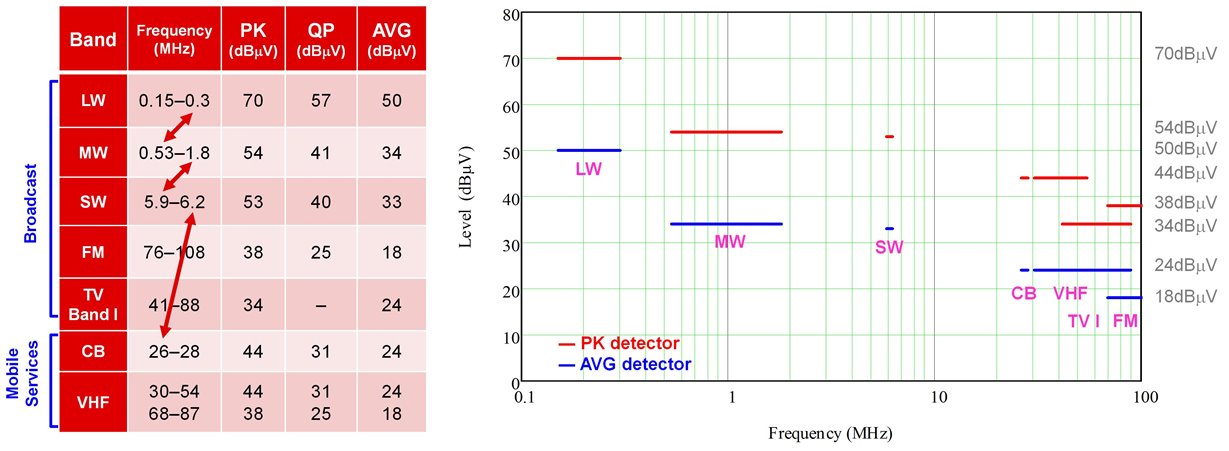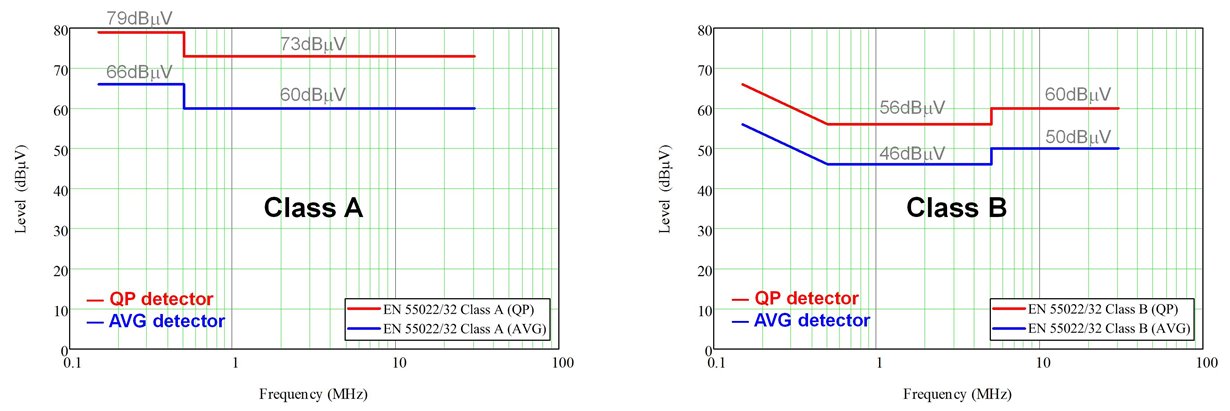-
A Review of EMI Standards, Part 1 – Conducted Emissions
A Review of EMI Standards, Part 1 – Conducted Emissions
Timothy Hegarty
In general, electrical products must meet some type of electromagnetic interference (EMI) performance metric, whether established in the product’s design specifications or to comply with regulatory requirements. It’s important to take into account any functional specifications that stipulate limits for EMI during the design phase of a project, particularly with respect to printed circuit board (PCB) layout and noise filtering. In part 1 of this series, I’ll review standards for conducted EMI in automotive, communications and industrial applications. Table 1 provides a list of relevant abbreviations.
| IEC | International Electrotechnical Commission |
| CISPR 25 | Comité International Spécial des Perturbations Radioélectriques, an IEC technical committee |
| EN 55032 | A modified derivative of CISPR 32 prepared by CENELC and ratified by the EU |
| FCC Part 15 | Federal Communications Commission; Part 15 subpart B applies to unintentional radiators |
| UNECE | United Nations Economic Commission for Europe |
| CE Mark | Conformité Européene |
| CENELEC | Comité Européene de Normalisation Électrotechnique |
| EN | European Norm |
EMI Standards for Automotive
From a regulatory standpoint, UNECE Regulation 10, titled “Uniform provisions concerning the approval of vehicles with regard to electromagnetic compatibility,” replaced the European Union’s (EU) Automotive Electromagnetic Compatibility (EMC) Directive 2004/104/EC in November 2014. UNECE Regulation 10 requires that manufacturers gain type approval for all vehicles, electronic sub-assemblies, components and separate technical units. Of course, automotive manufacturing has evolved into a global business, and the requirements and standards in this specification have broader relevance than the EU.
From an automotive electronic product designer’s perspective, the CISPR 25 product standard specifies the critical conducted emissions tests that apply at both the overall vehicle level as well as to automotive components and modules. Measurements are performed using one or two 5µH/50Ω artificial networks, depending on the grounding configuration. Conducted noise is measured over a frequency range from 150kHz to 108MHz. Because CISPR 25 refers to the “protection of on-board receivers,” the relevant frequency bands are dispersed across the AM broadcast, FM broadcast and mobile service bands, as shown in Figure 1. The limit lines in red and blue are the Class 5 peak (PK) and average (AVG) limits. PK limits are generally 20dB higher than the AVG limits.
 Figure 1 CISPR 25 Class 5 Conducted
Emission Limits with Peak (PK) and Average (AVG) Detectors
Figure 1 CISPR 25 Class 5 Conducted
Emission Limits with Peak (PK) and Average (AVG) DetectorsFigure 1 also plots the relevant limit lines for Class 5, the most stringent requirement from CISPR 25. Automotive manufacturers typically leverage this standard and may choose to extend or adjust the limits and frequency ranges according to their specific in-house requirements. The limits are extremely challenging, particularly the 18dBµV average (and 38dBµV peak) limit in the VHF and FM bands (68MHz to 87MHz and 87MHz to 108MHz, respectively).
EMI Standards for Communications Equipment
Power-supply products marketed for communications products and information technology equipment (ITE) within the EU have typically used the well-known CISPR 22 (or its European Standard equivalent, EN 55022) over many years, with the CE Declaration of Conformity (DoC) for external power supplies referencing this standard to show conformance with the EU’s EMC Directive 2014/30/EU. CISPR 22/EN 55022 was recently subsumed into CISPR 32/EN 55032, however. This new standard, targeted at multimedia equipment, becomes effective as a harmonized emission standard in compliance with the EMC directive. More specifically, any product previously tested under EN 55022 that is shipped into the EU after March 2, 2017, must now meet the requirements of EN 55032.
Figure 1 shows the EN 55022/32 Class A and Class B limits for conducted emissions with quasi-peak (QP) and AVG detectors over the frequency range of 150kHz to 30MHz.
 Figure 2 EN 55032 Class A and Class B
Conducted Emission Limits
Figure 2 EN 55032 Class A and Class B
Conducted Emission LimitsSimilarly, products designed for North American markets have complied with equivalent limits established by the FCC Part 15 Subpart B for unintentional radiators. Section 15.107 establishes limits for conducted emissions effectively equivalent to those in CISPR 22.
EMI Standards for Industrial
CISPR 11 is the international product standard for EMI disturbances from industrial, scientific and medical (ISM) equipment. Groups 1 and 2 are defined with scope for general-purpose and ISM radio-frequency applications, respectively. Each group is further subdivided in two classes: Class A equipment is for use in all establishments other than domestic and may be measured on a test site or in situ, whereas Class B covers domestic establishments and is measured only on a test site.
Meanwhile, IEC 61000-6-3 and IEC 61000-6-4 are “generic” EMC standards that apply to products targeted for residential/commercial/light-industrial and industrial environments, respectively, particularly if a product-specific standard is unavailable.
Summary
EMI is an increasingly challenging topic for fast-switching power converters. Commercial products for automotive, industrial and communications equipment are designed to minimize the amount of EMI produced during normal operation. Thus, an understanding of the EMI standards pertaining to the application is essential. The first installment of this blog series reviewed relevant standards for conducted EMI. In part 2, I’ll discuss standards for radiated EMI.
Additional Resources
- Read the article series, “The engineer’s guide to EMI in DC/DC converters.”
- Take the EMI training webinar, “Understanding EMI and mitigating noise in DC/DC converters.”
- Examine the CISPR 22/25 EMI results provided with these reference designs in the TI Designs library:
- Order the EMI-optimized evaluation module for the LM73606-Q1 36V, 6A automotive buck converter.
- Read the Analog Applications Journal article, “Reduce buck-converter EMI and voltage stress by minimizing inductive parasitics.”
- Download the white paper, “An overview of conducted EMI specifications for power supplies.”
IMPORTANT NOTICE AND DISCLAIMER
TI PROVIDES TECHNICAL AND RELIABILITY DATA (INCLUDING DATASHEETS), DESIGN RESOURCES (INCLUDING REFERENCE DESIGNS), APPLICATION OR OTHER DESIGN ADVICE, WEB TOOLS, SAFETY INFORMATION, AND OTHER RESOURCES “AS IS” AND WITH ALL FAULTS, AND DISCLAIMS ALL WARRANTIES, EXPRESS AND IMPLIED, INCLUDING WITHOUT LIMITATION ANY IMPLIED WARRANTIES OF MERCHANTABILITY, FITNESS FOR A PARTICULAR PURPOSE OR NON-INFRINGEMENT OF THIRD PARTY INTELLECTUAL PROPERTY RIGHTS.
These resources are intended for skilled developers designing with TI products. You are solely responsible for (1) selecting the appropriate TI products for your application, (2) designing, validating and testing your application, and (3) ensuring your application meets applicable standards, and any other safety, security, or other requirements. These resources are subject to change without notice. TI grants you permission to use these resources only for development of an application that uses the TI products described in the resource. Other reproduction and display of these resources is prohibited. No license is granted to any other TI intellectual property right or to any third party intellectual property right. TI disclaims responsibility for, and you will fully indemnify TI and its representatives against, any claims, damages, costs, losses, and liabilities arising out of your use of these resources.
TI’s products are provided subject to TI’s Terms of Sale (www.ti.com/legal/termsofsale.html) or other applicable terms available either on ti.com or provided in conjunction with such TI products. TI’s provision of these resources does not expand or otherwise alter TI’s applicable warranties or warranty disclaimers for TI products.
Mailing Address: Texas Instruments, Post Office Box 655303, Dallas, Texas 75265
Copyright © 2023, Texas Instruments Incorporated